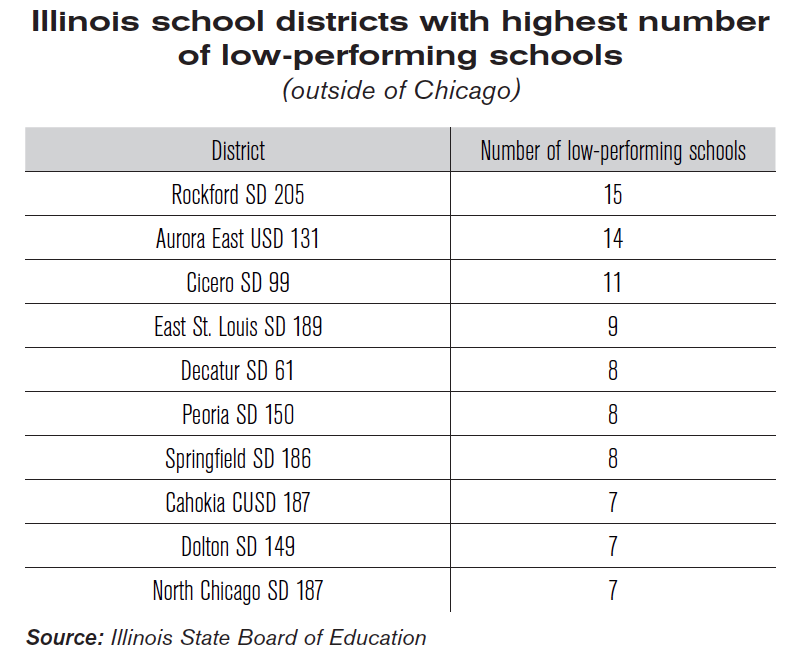Most people assume that Chicago is home to Illinois’ lowest-performing schools.
And that’s not a far-fetched belief – Chicago’s lowest-performing schools are doing a dismal job of teaching students the knowledge and skills they need to succeed in the future.
But Chicago is home to only 45 percent of the state’s lowest-performing elementary schools and high schools. More than half of Illinois’ lowest-performing schools lie outside of the city’s borders.
 A look at the performance data shows just how poor of a job these schools are doing at preparing the next generation of students.
A look at the performance data shows just how poor of a job these schools are doing at preparing the next generation of students.
- Seventy-two percent of students at Illinois’ lowest-performing elementary schools failed to meet standards in math. Fifty-three percent are one grade level behind, and 19 percent are two or more grade levels behind. Eighth-grade students who are one grade level behind in math have difficulty solving one-step equations that involve addition, subtraction, multiplication and division, while those who are two or more grade levels behind cannot solve fraction problems even when they have common denominators.
- Seventy-two percent of third-graders at Illinois’ lowest-performing elementary schools failed to meet standards in reading. Third-grade students who are behind in reading are unable to distinguish between the main idea and supporting details of a story.
- More than one-third of students at Illinois’ lowest-performing high schools can only do middle-school math.
- Only 6 percent of students at Illinois’ lowest-performing high schools score well enough on the ACT to be considered college-ready. This means they have at least a 50 percent chance of getting a “B” or a 75 percent chance of a getting “C” in freshman college classes in reading, writing, math and science.
Research shows that students who lack basic math and reading skills are more likely to drop out of high school, are less likely to graduate from college, are incarcerated at higher rates, are more likely to be unemployed, are more likely to enroll in public assistance programs and will make significantly less money than their peers who received quality educations.
The stakes are incredibly high. A recent study conducted by researchers at Harvard University showed that a child born into poverty in Illinois has only a 6.1 percent chance of earning an annual wage of more than $100,000 by the time they’re 40 – one of the lowest rates among all 50 states.
It also found that the areas with the highest rates of income mobility were those with the highest-quality schools, public or otherwise.
Parents of students in the state’s lowest-performing schools want the option to send their child to a higher-quality school. In fact, a recent We Ask America survey showed nearly 50 percent would use the money currently being spent on their children at a public school to pay tuition at a school of their choice.
It’s time for legislators to give them that option, and ensure that students at Illinois’ lowest-performing elementary schools and high schools will receive an education that will make a difference in their lives.
Voice of the people: Families in Illinois’ lowest-performing districts want school choice
Students in Illinois’ lowest-performing schools should be able to use the money being spent on them in their public schools to attend higher-quality schools, regardless of whether these schools are public, charter or private.
That’s not the Illinois Policy Institute talking – it’s the parents and relatives of students attending some of the state’s persistently low-performing schools.
A recent We Ask America poll, commissioned by the Illinois Policy Institute, shows, on average, that a majority of families in districts with the highest number of low-performing schools want to use the money being spent on their family member at his or her public school to pay tuition at the school of their choice instead.
The poll – which ran in late February – asked parents and relatives of students attending public schools in six different school districts (City of Chicago School District 299, Aurora East Unified School District 131, East St. Louis School District 189, Rockford School District 205, Springfield School District 186 and Waukegan Community Unit School District 60) to answer a series of questions about the quality of the public school their child or relative attends. The survey also asked a question about whether the family member would instead use the money being spent on their child or relative for public school to pay tuition at a school of their choice.
Here is how the questions were worded:
- How would you grade your child’s or relative’s school on an A to F scale?
- If you could use the money that is currently being spent on your child or relative at his or her public school to pay tuition at a school of your choice, would you?
Here’s the district-by-district breakdown of the answers to these questions.
These results make sense. Take a look at some statistics from “Trapped in Illinois’ worst schools: Education outcomes in Illinois’ lowest-performing public schools.”
It’s clear – from these poll results and the consistently poor performance of Illinois’ lowest performing schools – that parents of students in these schools want and deserve the option to send their child to a higher-quality school.
It’s time for legislators to give them that option – to ensure that students at Illinois’ lowest-performing elementary schools and high schools will receive an education that will make a positive difference in their lives.

